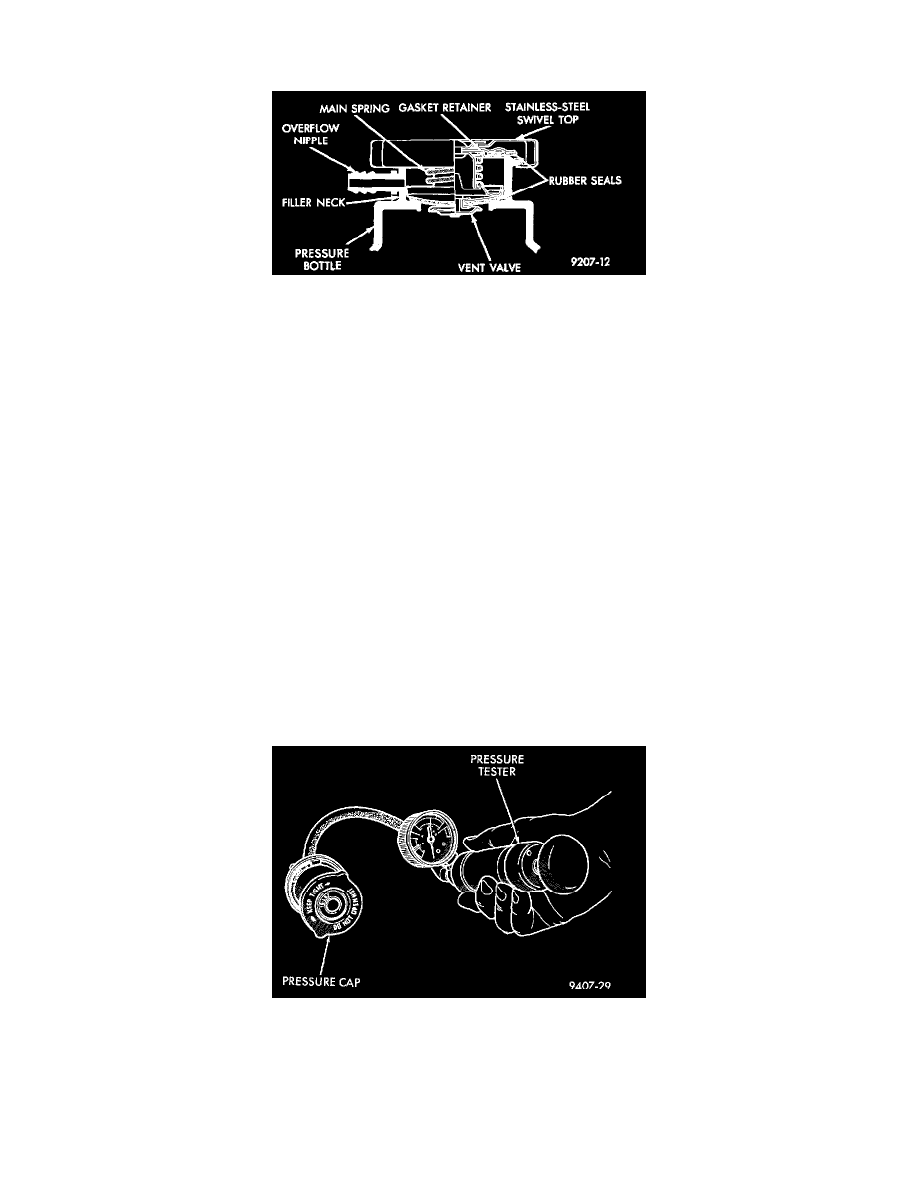Grand Caravan FWD V6-3.0L VIN 3 (1999)

Radiator Cap: Testing and Inspection
RADIATOR CAP TO FILLER NECK SEAL PRESSURE RELIEF CHECK
Radiator Pressure Cap Filler Neck
The pressure cap upper gasket (seal) pressure relief can be checked by removing the overflow hose at the radiator filler neck nipple. Attach the
Radiator Pressure Tool to the filler neck nipple and pump air into the radiator. Pressure cap upper gasket should relieve at 69-124 kPa (10-18 psi) and
hold pressure at 55 kPa (8 psi) minimum.
WARNING: THE WARNING WORDS "DO NOT OPEN HOT" ON THE RADIATOR PRESSURE CAP IS A SAFETY PRECAUTION.
WHEN HOT, PRESSURE BUILDS UP IN COOLING SYSTEM. TO PREVENT SCALDING OR INJURY, THE RADIATOR CAP
SHOULD NOT BE REMOVED WHILE THE SYSTEM IS HOT OR UNDER PRESSURE.
There is no need to remove the radiator cap at any time except for the following purposes:
1. Check and adjust coolant freeze point. By adding or subtracting coolant through CRS bottle.
2. Refill system with new coolant.
3. Conducting service procedures.
4. Checking for vacuum leaks.
WARNING: IF VEHICLE HAS BEEN RUN RECENTLY. WAIT 15 MINUTES BEFORE REMOVING CAP. THEN PLACE A SHOP
TOWEL OVER THE CAP AND WITHOUT PUSHING DOWN, ROTATE COUNTERCLOCKWISE TO THE FIRST STOP. ALLOW
FLUIDS TO ESCAPE THROUGH THE OVERFLOW TUBE AND WHEN THE SYSTEM STOPS PUSHING COOLANT AND
STEAM INTO THE CRS TANK AND PRESSURE DROPS, PUSH DOWN AND REMOVE THE CAP COMPLETELY. SQUEEZING
THE RADIATOR INLET HOSE WITH A SHOP TOWEL (TO CHECK PRESSURE) BEFORE AND AFTER TURNING TO THE
FIRST STOP IS RECOMMENDED.
PRESSURE TESTING RADIATOR CAP
Dip the pressure cap in water, clean any deposits off the vent valve or its seat and apply cap to end of Radiator Pressure Tool. Working the plunger,
bring the pressure to 104 kPa (15 psi) on the gauge. If the pressure cap fails to hold pressure of at least 97 kPa (14 psi) replace cap.
Pressure Testing Radiator Cap
If the pressure cap tests properly while positioned on Radiator Pressure Tool, but will not hold pressure or vacuum when positioned on the radiator.
Inspect the radiator filler neck and cap top gasket for irregularities that may prevent the cap from sealing properly.
CAUTION: Radiator Pressure Tool is very sensitive to small air leaks that will not cause cooling system problems. A pressure cap that does not have
a history of coolant loss should not be replaced just because it leaks slowly when tested with this tool. Add water to the tool. Turn tool upside down
and recheck pressure cap to confirm that cap is bad.
